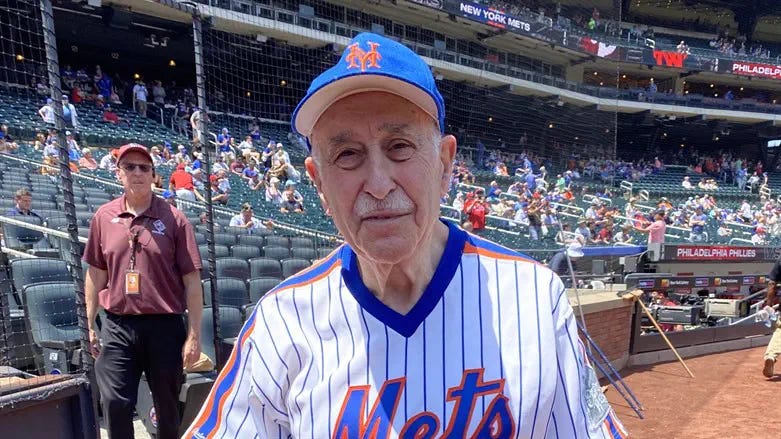The Past is a Foreign Country
'The past is a foreign country; they do things differently there.' - L.P. Hartley
Writer L.P. Hartley once wrote, The past is a foreign country; they do things differently there.
I often think about that when I am researching and writing content for @MetsRewind. Reporting on history can be tricky. I don’t want to oversimplify stories to suggest the reader is ignorant; but I also don’t want to assume the reader knows the finer details.
The younger fan isn’t likely to know Marv Throneberry, Choo Choo Coleman or Salty Parker — they are foreigners, as Hartley stated — but younger Mets fans sure do know their way around David Wright, R.A. Dickey and Johan Santana.
It’s a delicate dance, one that I take great pleasure in trying to create for Mets fans (and baseball lovers) of all ages.
SEEING THE GAME
The past must always be considered in context; ideas must always be understood in light of the time period in which they were written. — Quentin Skinner
Seeing the game through another fans eyes — especially fans of a certain age (75+) — is beautiful; it’s a gift. An older fans perspective is entirely different. They grew up decades before social media and digital platforms, they listened to games on transistor radios and bought newspapers to find out the latest team news.
There is a lot of baseball wisdom that comes out of a person who has been watching one team for 60+ years. The knowledge, experiences and opinions come from a time that is foreign to many of today’s fans.
PODCAST: ROBERT LIPSYTE
For me, personally, I love to listen to Mets stories from those fans who had the experience of seeing the team play during The Genesis Years of 1962, 1963 and the subequent years of the 1960s.
I encourage you to find a senior Mets fan, whether its at Citi Field, in a coffee shop or bookstore, and pepper them with questions about their memories and experiences of watching those early Mets teams.
Then, sit back and listen.
It’s often messy and untrustworthy. That does not mean that the past has not had its way with us - shaping us, haunting us, defining us, motivating us, empowering us.
"What we have in common as human beings is that we employ the past to make sense of the present and to influence the future," said historian David Thelen.
History depends on someone else's eyes and voice: we see history through an interpreter. Because of this inevitability, historians must come to grips with the fact that they will never be able to provide a complete and thorough account of what happened in the past. Postmodern historians argue that no single narrative is capable of actually capturing the past because it will always be a product of bias.
There is a distinction between history and the past. The past is the past - a record of events; dates, facts and things that happened. History is a discipline; it is the art of reconstructing the past.
POLO GROUNDS
Whever I can get a generational Mets fan to talk about the Polo Grounds — players they watched, the ballpark asthetics, Casey Stengel — I am thrilled. The Mets played their first two seasons (1962-1963) at The Polo Grounds. I was born in 1964.
AUTHOR BILL RYCZEK ON THE POLO GROUNDS
Everything about those two years are foreign to me. I am left to books, newspaper clippings, black-and-white photos, short video clips, and a collection of fans, mostly septuagenarians and beyond.
When I speak to a Robert Lipsyte, Marc Gold or Bill Ryczek I feel like Rod Serling is going to walk in at second and introduce the next episode of the Twilight Zone.
PODCAST: MARC GOLD
"Any good history begins in strangeness,” says historian Richard White. “The past should not be comfortable. The past should not a familiar echo of the present, for if it is similar, why revisit it? The past should be so strange that you wonder how you and people you know and love could come from such a time."
Of the 30 Major League Baseball clubs today, the case could be made that no other team has a more compelling franchise history than the New York Mets. From Casey Stengel to Yogi Berra, Marv Throneberry to Tom Seaver, Willie Mays, Tug McGraw, Darryl Strawberry, Dwight Gooden, Keith Hernandez, Bobby Valentine, Pedro Martinez, Matt Harvey and Pete Alonso, the Mets are loaded with character(s).
So, what’s the point? I hope you will join me on this journey into New York Mets baseball history. When you see a chance, take it. Ask your granparents to sit down one day and ask them about their memories of the early Mets, the Polo Grounds and what it felt like, smelled like, looked like.
And, just listen. Like me, you may find yourself in a foreign place far, far away.
ABOUT METSREWIND
New York was redefined on March 6, 1961 when the New York Metropolitan Baseball Club Inc. formally received a certificate of membership from league president Warren Giles.
Of the 30 Major League Baseball clubs today, the case could be made that no other team has a more compelling franchise history than the New York Mets. From Casey Stengel to Yogi Berra, Marv Throneberry to Tom Seaver, Willie Mays, Tug McGraw, Darryl Strawberry, Dwight Gooden, Keith Hernandez, Bobby Valentine, Pedro Martinez, Matt Harvey and Pete Alonso, the Mets are loaded with character(s).
Then there are the Amazin’ seasons — 1962, 1969, 1973, 1986, 2000, 2006-2008 and 2015 — full of miracles, joy, hope and heartbreak.
@MetsRewind is designed to share team history in unique and entertaining digital formats including Twitter, Instagram, and Substack.
We hope you — the baseball fan — enjoy the content. We encourage you to share your memories.




